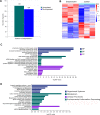Transcriptome analysis unveils the mechanisms of lipid metabolism response to grayanotoxin I stress in Spodoptera litura
- PMID: 38077416
- PMCID: PMC10710133
- DOI: 10.7717/peerj.16238
Transcriptome analysis unveils the mechanisms of lipid metabolism response to grayanotoxin I stress in Spodoptera litura
Abstract
Background: Spodoptera litura (tobacco caterpillar, S. litura) is a pest of great economic importance due to being a polyphagous and world-distributed agricultural pest. However, agricultural practices involving chemical pesticides have caused resistance, resurgence, and residue problems, highlighting the need for new, environmentally friendly methods to control the spread of S. litura.
Aim: This study aimed to investigate the gut poisoning of grayanotoxin I, an active compound found in Pieris japonica, on S. litura, and to explore the underlying mechanisms of these effects.
Methods: S. litura was cultivated in a laboratory setting, and their survival rate, growth and development, and pupation time were recorded after grayanotoxin I treatment. RNA-Seq was utilized to screen for differentially expressed genes (DEGs). Gene Ontology (GO) and Kyoto Encyclopedia of Genes and Genomes (KEGG) pathway enrichment analyses were conducted to determine the functions of these DEGs. ELISA was employed to analyze the levels of lipase, 3-hydroxyacyl-CoA dehydrogenase (HOAD), and acetyl-CoA carboxylase (ACC). Hematoxylin and Eosin (H & E) staining was used to detect the development of the fat body.
Results: Grayanotoxin I treatment significantly suppressed the survival rate, growth and development, and pupation of S. litura. RNA-Seq analysis revealed 285 DEGs after grayanotoxin I exposure, with over 16 genes related to lipid metabolism. These 285 DEGs were enriched in the categories of cuticle development, larvae longevity, fat digestion and absorption. Grayanotoxin I treatment also inhibited the levels of FFA, lipase, and HOAD in the hemolymph of S. litura.
Conclusion: The results of this study demonstrated that grayanotoxin I inhibited the growth and development of S. litura. The mechanisms might, at least partly, be related to the interference of lipid synthesis, lipolysis, and fat body development. These findings provide valuable insights into a new, environmentally-friendly plant-derived insecticide, grayanotoxin I, to control the spread of S. litura.
Keywords: Grayanotoxin I; Lipid metabolism; Spodoptera litura.
©2023 Zhou et al.
Conflict of interest statement
The authors declare there are no competing interests.
Figures





Similar articles
-
Transcriptomics and metagenomics of common cutworm (Spodoptera litura) and fall armyworm (Spodoptera frugiperda) demonstrate differences in detoxification and development.BMC Genomics. 2022 May 20;23(1):388. doi: 10.1186/s12864-022-08613-6. BMC Genomics. 2022. PMID: 35596140 Free PMC article.
-
Identification of transcriptome and fluralaner responsive genes in the common cutworm Spodoptera litura Fabricius, based on RNA-seq.BMC Genomics. 2020 Feb 3;21(1):120. doi: 10.1186/s12864-020-6533-0. BMC Genomics. 2020. PMID: 32013879 Free PMC article.
-
Integration of transcriptome and proteome reveals molecular mechanisms underlying stress responses of the cutworm, Spodoptera litura, exposed to different levels of lead (Pb).Chemosphere. 2021 Nov;283:131205. doi: 10.1016/j.chemosphere.2021.131205. Epub 2021 Jun 14. Chemosphere. 2021. PMID: 34147986
-
Toosendanin inhibits the growth of Spodoptera litura by inducing metabolic dysfunction in the midgut.Pestic Biochem Physiol. 2025 Mar;208:106249. doi: 10.1016/j.pestbp.2024.106249. Epub 2024 Dec 10. Pestic Biochem Physiol. 2025. PMID: 40015845
-
RNA-Seq Analyses of Midgut and Fat Body Tissues Reveal the Molecular Mechanism Underlying Spodoptera litura Resistance to Tomatine.Front Physiol. 2019 Jan 22;10:8. doi: 10.3389/fphys.2019.00008. eCollection 2019. Front Physiol. 2019. PMID: 30723417 Free PMC article.
References
MeSH terms
Substances
LinkOut - more resources
Full Text Sources

